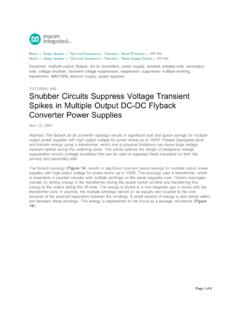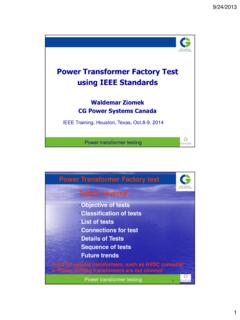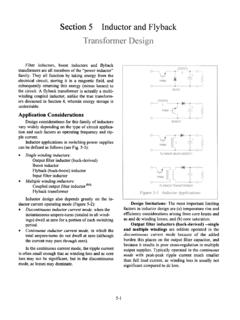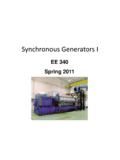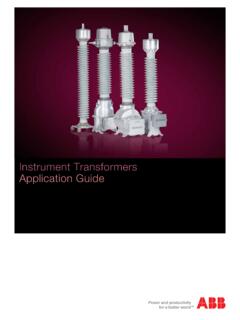Transcription of 1. Explain the Working principle of transformer
1 1 1. Explain the Working principle of transformer 1. The basic Working principle of a transformer is mutual induction between two windings linked by common magnetic flux. 2. The primary and secondary coils are electrically separated but magnetically linked to each other. 3. When, primary winding is connected to a source of alternating voltage, alternating magnetic flux is produced around the winding . 4. The core provides magnetic path for the flux, to get linked with the secondary winding . Most of the flux gets linked with the secondary winding which is called as 'useful flux' or main 'flux', and the flux which does not get linked with secondary winding is called as 'leakage flux'.
2 5. As the flux produced is alternating (the direction of it is continuously changing), EMF gets induced in the secondary winding according to Faraday's law of electromagnetic induction. This induced emf is called 'mutually induced emf', and the frequency of mutually induced emf is same as that of supplied emf. Thus, in a transformer the frequency is same on both sides. 6. If the secondary winding is closed circuit, then mutually induced makes the current flow through it, and hence the electrical energy is transferred from one circuit (primary) to another circuit (secondary).
3 2. Derive the EMF Equation of a transformer Let m = Maximum value of flux in Weber f = Supply frequency in Hz N1 = Number of turns in the primary winding N2 = Number of turns in the secondary winding = flux per turn in Weber As per the faradays laws, The average value of the emf induced is directly proportional to the rate of change of flux. The flux changes from + m to m in half a cycle of 1/2f seconds. Flux increases from its zero value to maximum value m in one quarter of the cycle in of the timeperiod. Average rate of change of flux is d m 0 4 f volts dt 1 m 4 f 2 1 m 1 2 m 2 Therefore the average per turn is 4 m f As Rmsvalue Averagevalue Formfactor for sinusoidal varying quatities Hence, RMS value of is * 4 m f m f RMS value of in the primary & secondary winding .
4 =( ) * No:of turns Therefore Emf induced in primary winding having N1turns is E fN Emf induced in secondary winding having N2 turns is 3. Explain the Construction of transformer E fN 1. The simple construction of a transformer , need two coils having mutual inductance and a laminated steel core. 2. The two coils are insulated from each other and from the steel core. 3. The device will also need some suitable container for the assembled core and windings, a medium with which the core and its windings from its container can be insulated.
5 4. In order to insulate and to bring out the terminals of the winding from the tank, bushings made of porcelain are used. 5. In all transformers , the core is made of transformer sheet steel laminations assembled to provide a continuous magnetic path with minimum of air-gap included. 6. The steel should have high permeability and low hysteresis loss. For this to happen, the steel should be made of high silicon content and must also be heat treated. 7. By effectively laminating the core, the eddy-current losses can be reduced.
6 The lamination can be done with the help of a light coat of core plate varnish or lay an oxide layer on the surface. For a frequency of 50 Hertz, the thickness of the lamination varies from to for a frequency of 25 Hertz. 8. To reduce the leakage fluxes in the transformer the windings of the primary and secondary coils are interleaved in the core type and sandwiched coils in the shell type. 9. To reduce the volume of the cu wire the core used must be the stepped core or cruciform core. 4. Compare and distinguish the types of transformers There are two major types of transformers based on construction.
7 1. Core type 2. Shell type Core type transformer Shell type transformer 1 The winding encircles the core The core encircles the winding 2 The cylindrical type of coils are used Generally multilayer disc type or sandwiched coils coils are used 3 As windings are distributed, the natural cooling is more effective As windings are surrounded by the core, the natural cooling does not exists. 4 The coils can be easily removed from the maintenance point of view For removing any winding for maintenance, a large number of laminations are to be removed. This is difficult.
8 5 The construction is preferred for low voltage transformers The construction is used for very high voltage transformers 6 It has a single magnetic core It has a double magnetic core 7 In a single phase type there are two Limbs In a single phase type the core has three Limbs 3 2. Discuss the losses and efficiency in the transformer transformer is a static device, it doesn t have any parts, so no mechanical losses exist in the transformer and only electrical losses are observed. So there are two primary types of losses in the transformer : 1. Copper losses 2.
9 Iron losses Other than these, some small amount of power losses in the form of stray losses are also observed, which are produced due to the leakage of magnetic flux. 4 f Copper losses 1. These losses occur in the windings of the transformer when heat is dissipated due to the current passing through the windings and the internal resistance offered by the windings. 2. So these are also known as ohmic losses or I2R losses, where I is the current passing through the windings and R is the internal resistance of the windings. 3.
10 These losses are present both in the primary and secondary windings of the transformer and depend upon the load attached across the secondary windings since the current varies with the variation in the load, so these are variable losses. Iron losses or Core Losses 1. These losses occur in the core of the transformer and are generated due to the variations in the flux. 2. These losses depend upon the magnetic properties of the materials which are present in the core, so they are also known as iron losses, as the core of the transformer is made up of iron.

